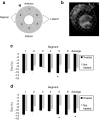Long-term restoration of cardiac dystrophin expression in golden retriever muscular dystrophy following rAAV6-mediated exon skipping
- PMID: 22146342
- PMCID: PMC3293605
- DOI: 10.1038/mt.2011.264
Long-term restoration of cardiac dystrophin expression in golden retriever muscular dystrophy following rAAV6-mediated exon skipping
Abstract
Although restoration of dystrophin expression via exon skipping in both cardiac and skeletal muscle has been successfully demonstrated in the mdx mouse, restoration of cardiac dystrophin expression in large animal models of Duchenne muscular dystrophy (DMD) has proven to be a challenge. In large animals, investigators have focused on using intravenous injection of antisense oligonucleotides (AO) to mediate exon skipping. In this study, we sought to optimize restoration of cardiac dystrophin expression in the golden retriever muscular dystrophy (GRMD) model using percutaneous transendocardial delivery of recombinant AAV6 (rAAV6) to deliver a modified U7 small nuclear RNA (snRNA) carrying antisense sequence to target the exon splicing enhancers of exons 6 and 8 and correct the disrupted reading frame. We demonstrate restoration of cardiac dystrophin expression at 13 months confirmed by reverse transcription-PCR (RT-PCR) and immunoblot as well as membrane localization by immunohistochemistry. This was accompanied by improved cardiac function as assessed by cardiac magnetic resonance imaging (MRI). Percutaneous transendocardial delivery of rAAV6 expressing a modified U7 exon skipping construct is a safe, effective method for restoration of dystrophin expression and improvement of cardiac function in the GRMD canine and may be easily translatable to human DMD patients.
Figures







Similar articles
-
Muscle function recovery in golden retriever muscular dystrophy after AAV1-U7 exon skipping.Mol Ther. 2012 Nov;20(11):2120-33. doi: 10.1038/mt.2012.181. Epub 2012 Sep 11. Mol Ther. 2012. PMID: 22968479 Free PMC article.
-
MRI roadmap-guided transendocardial delivery of exon-skipping recombinant adeno-associated virus restores dystrophin expression in a canine model of Duchenne muscular dystrophy.Gene Ther. 2013 Mar;20(3):274-82. doi: 10.1038/gt.2012.38. Epub 2012 May 3. Gene Ther. 2013. PMID: 22551778 Free PMC article.
-
Engineering exon-skipping vectors expressing U7 snRNA constructs for Duchenne muscular dystrophy gene therapy.Methods Mol Biol. 2011;709:179-96. doi: 10.1007/978-1-61737-982-6_11. Methods Mol Biol. 2011. PMID: 21194028
-
Molecular correction of Duchenne muscular dystrophy by splice modulation and gene editing.RNA Biol. 2021 Jul;18(7):1048-1062. doi: 10.1080/15476286.2021.1874161. Epub 2021 Jan 20. RNA Biol. 2021. PMID: 33472516 Free PMC article. Review.
-
Skipping multiple exons of dystrophin transcripts using cocktail antisense oligonucleotides.Nucleic Acid Ther. 2014 Feb;24(1):57-68. doi: 10.1089/nat.2013.0451. Epub 2013 Dec 31. Nucleic Acid Ther. 2014. PMID: 24380394 Review.
Cited by
-
Forelimb treatment in a large cohort of dystrophic dogs supports delivery of a recombinant AAV for exon skipping in Duchenne patients.Mol Ther. 2014 Nov;22(11):1923-35. doi: 10.1038/mt.2014.151. Epub 2014 Aug 4. Mol Ther. 2014. PMID: 25200009 Free PMC article.
-
The golden retriever model of Duchenne muscular dystrophy.Skelet Muscle. 2017 May 19;7(1):9. doi: 10.1186/s13395-017-0124-z. Skelet Muscle. 2017. PMID: 28526070 Free PMC article. Review.
-
Canine and Feline Models of Human Genetic Diseases and Their Contributions to Advancing Clinical Therapies .Yale J Biol Med. 2017 Sep 25;90(3):417-431. eCollection 2017 Sep. Yale J Biol Med. 2017. PMID: 28955181 Free PMC article. Review.
-
Muscle function recovery in golden retriever muscular dystrophy after AAV1-U7 exon skipping.Mol Ther. 2012 Nov;20(11):2120-33. doi: 10.1038/mt.2012.181. Epub 2012 Sep 11. Mol Ther. 2012. PMID: 22968479 Free PMC article.
-
Exon Skipping in a Dysf-Missense Mutant Mouse Model.Mol Ther Nucleic Acids. 2018 Dec 7;13:198-207. doi: 10.1016/j.omtn.2018.08.013. Epub 2018 Aug 22. Mol Ther Nucleic Acids. 2018. PMID: 30292141 Free PMC article.
References
-
- Emery AE. The muscular dystrophies. Lancet. 2002;359:687–695. - PubMed
-
- Aartsma-Rus A, Van Deutekom JC, Fokkema IF, Van Ommen GJ., and, Den Dunnen JT. Entries in the Leiden Duchenne muscular dystrophy mutation database: an overview of mutation types and paradoxical cases that confirm the reading-frame rule. Muscle Nerve. 2006;34:135–144. - PubMed
-
- Miyagoe-Suzuki Y., and, Takeda S. Gene therapy for muscle disease. Exp Cell Res. 2010;316:3087–3092. - PubMed
-
- Moulton HM., and, Moulton JD. Morpholinos and their peptide conjugates: therapeutic promise and challenge for Duchenne muscular dystrophy. Biochim Biophys Acta. 2010;1798:2296–2303. - PubMed
Publication types
MeSH terms
Substances
Grants and funding
LinkOut - more resources
Full Text Sources
Other Literature Sources

